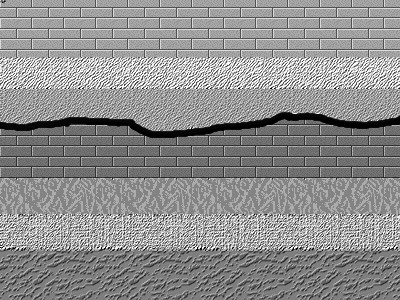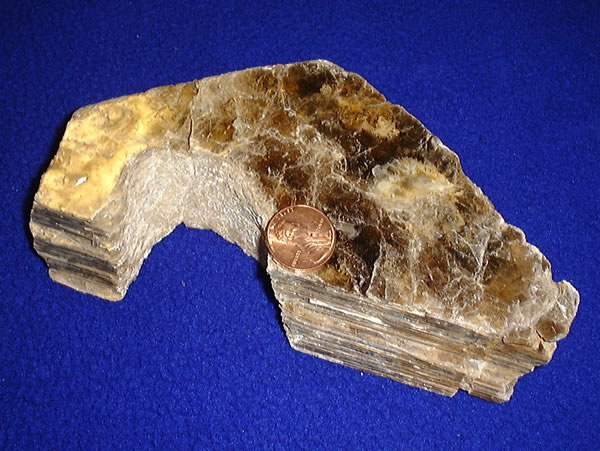|
Río Cachirí Group
The Río Cachirí Group (, PZc) is a group (geology), geological group of the Cesar-Ranchería Basin, Colombia and the Serranía del Perijá of the northernmost Colombian and Venezuelan Andes. The group of shales, sandstones and limestones is of Devonian age and has a maximum thickness in the Venezuelan section of . The group contains abundant fauna; crinoids, bryozoa, brachiopods and molluscs have been found in the group. Etymology and definition The formation was defined by Liddle in 1928 in Mara, Zulia, Río Cachirí, part of Mara, Zulia, in the Venezuelan part of the Serranía del Perijá, and the same author subdivided the group into three formations in 1943. In 1972, Bowen added a fourth formation to the group.Ayala, 2009, p.20 Description Lithologies The group contains black, grey and red shales, grey micaceous sandstones, quartzite, quartzitic sandstones and red and bluish grey limestones. Stratigraphy and correlation The Río Cachirí Group, dated to span the De ... [...More Info...] [...Related Items...] OR: [Wikipedia] [Google] [Baidu] |
Devonian
The Devonian ( ) is a period (geology), geologic period and system (stratigraphy), system of the Paleozoic era (geology), era during the Phanerozoic eon (geology), eon, spanning 60.3 million years from the end of the preceding Silurian period at million years ago (Megaannum, Ma), to the beginning of the succeeding Carboniferous period at Ma. It is the fourth period of both the Paleozoic and the Phanerozoic. It is named after Devon, South West England, where rocks from this period were first studied. The first significant evolutionary radiation of history of life#Colonization of land, life on land occurred during the Devonian, as free-spore, sporing land plants (pteridophytes) began to spread across dry land, forming extensive coal forests which covered the continents. By the middle of the Devonian, several groups of vascular plants had evolved leaf, leaves and true roots, and by the end of the period the first seed-bearing plants (Pteridospermatophyta, pteridospermatophyt ... [...More Info...] [...Related Items...] OR: [Wikipedia] [Google] [Baidu] |
Floresta Formation
The Floresta Formation (, Df) is a geological formation of the Altiplano Cundiboyacense in the Eastern Ranges of the Colombian Andes. The sequence of siltstones, shales, coquinas and sandstone beds dates to the Devonian period; Late Emsian, Eifelian and Early Givetian epochs, and has a maximum thickness of . The unit is highly fossiliferous; brachiopods, bryozoans, gastropods, trilobites, corals and bivalves have been found in the Floresta Formation. Some fragments of Placoderm fish fossils were found in the Floresta Formation, while the overlying Cuche Formation is much richer in fish biodiversity. Etymology The formation was first described as Floresta Series by Olsson and Carter in 1939. The current definition was given by Botero in 1950. The formation is named after Floresta, Boyacá, where the formation outcrops.Mojica & Villarroel, 1984, p.64 Description Lithologies The Floresta Formation is characterized by a lower sequence of shales and ochre to beige siltston ... [...More Info...] [...Related Items...] OR: [Wikipedia] [Google] [Baidu] |
Carboniferous
The Carboniferous ( ) is a Geologic time scale, geologic period and System (stratigraphy), system of the Paleozoic era (geology), era that spans 60 million years, from the end of the Devonian Period Ma (million years ago) to the beginning of the Permian Period, Ma. It is the fifth and penultimate period of the Paleozoic era and the fifth period of the Phanerozoic eon (geology), eon. In North America, the Carboniferous is often treated as two separate geological periods, the earlier Mississippian (geology), Mississippian and the later Pennsylvanian (geology), Pennsylvanian. The name ''Carboniferous'' means "coal-bearing", from the Latin ("coal") and ("bear, carry"), and refers to the many coal beds formed globally during that time. The first of the modern "system" names, it was coined by geologists William Conybeare (geologist), William Conybeare and William Phillips (geologist), William Phillips in 1822, based on a study of the British rock succession. Carboniferous is the per ... [...More Info...] [...Related Items...] OR: [Wikipedia] [Google] [Baidu] |
Unconformity
An unconformity is a buried erosional or non-depositional surface separating two rock masses or strata of different ages, indicating that sediment deposition was not continuous. In general, the older layer was exposed to erosion for an interval of time before deposition of the younger layer, but the term is used to describe any break in the sedimentary geologic record. The significance of angular unconformity (see below) was shown by James Hutton, who found examples of Hutton's Unconformity at Jedburgh in 1787 and at Siccar Point in Berwickshire in 1788, both in Scotland. The rocks above an unconformity are younger than the rocks beneath (unless the sequence has been overturned). An unconformity represents time during which no sediments were preserved in a region or were subsequently eroded before the next deposition. The local record for that time interval is missing and geologists must use other clues to discover that part of the geologic history of that area. The interval ... [...More Info...] [...Related Items...] OR: [Wikipedia] [Google] [Baidu] |
Quartzite
Quartzite is a hard, non- foliated metamorphic rock that was originally pure quartz sandstone.Essentials of Geology, 3rd Edition, Stephen Marshak, p 182 Sandstone is converted into quartzite through heating and pressure usually related to tectonic compression within orogenic belts, and hence quartzite is a metasandstone. Pure quartzite is usually white to grey, though quartzites often occur in various shades of pink and red due to varying amounts of hematite. Other colors, such as yellow, green, blue and orange, are due to other minerals. The term ''quartzite'' is also sometimes used for very hard but unmetamorphosed sandstones that are composed of quartz grains thoroughly cemented with additional quartz. Such sedimentary rock has come to be described as orthoquartzite to distinguish it from metamorphic quartzite, which is sometimes called metaquartzite to emphasize its metamorphic origins. Quartzite is very resistant to chemical weathering and often forms ridges and resist ... [...More Info...] [...Related Items...] OR: [Wikipedia] [Google] [Baidu] |
Mica
Micas ( ) are a group of silicate minerals whose outstanding physical characteristic is that individual mica crystals can easily be split into fragile elastic plates. This characteristic is described as ''perfect basal cleavage''. Mica is common in igneous and metamorphic rock and is occasionally found as small flakes in sedimentary rock. It is particularly prominent in many granites, pegmatites, and schists, and "books" (large individual crystals) of mica several feet across have been found in some pegmatites. Micas are used in products such as drywalls, paints, and fillers, especially in parts for automobiles, roofing, and in electronics. The mineral is used in cosmetics and food to add "shimmer" or "frost". Properties and structure The mica group comprises 37 phyllosilicate minerals. All crystallize in the monoclinic system, with a tendency towards pseudohexagonal crystals, and are similar in structure but vary in chemical composition. Micas are translucent to opa ... [...More Info...] [...Related Items...] OR: [Wikipedia] [Google] [Baidu] |
Mollusc
Mollusca is a phylum of protostome, protostomic invertebrate animals, whose members are known as molluscs or mollusks (). Around 76,000 extant taxon, extant species of molluscs are recognized, making it the second-largest animal phylum after Arthropoda. The number of additional fossil species is estimated between 60,000 and 100,000, and the proportion of undescribed species is very high. Many taxa remain poorly studied. Molluscs are the largest marine biology, marine phylum, comprising about 23% of all the named marine organisms. They are highly diverse, not just in size and anatomical structure, but also in behaviour and habitat, as numerous groups are freshwater mollusc, freshwater and even terrestrial molluscs, terrestrial species. The phylum is typically divided into 7 or 8 taxonomy (biology), taxonomic class (biology), classes, of which two are entirely extinct. Cephalopod molluscs, such as squid, cuttlefish, and octopuses, are among the most neurobiology, neurologi ... [...More Info...] [...Related Items...] OR: [Wikipedia] [Google] [Baidu] |
Brachiopod
Brachiopods (), phylum (biology), phylum Brachiopoda, are a phylum of animals that have hard "valves" (shells) on the upper and lower surfaces, unlike the left and right arrangement in bivalve molluscs. Brachiopod valves are hinged at the rear end, while the front can be opened for feeding or closed for protection. Two major categories are traditionally recognized, articulate and inarticulate brachiopods. The word "articulate" is used to describe the tooth-and-groove structures of the valve-hinge which is present in the articulate group, and absent from the inarticulate group. This is the leading diagnostic skeletal feature, by which the two main groups can be readily distinguished as fossils. Articulate brachiopods have toothed hinges and simple, vertically oriented opening and closing muscles. Conversely, inarticulate brachiopods have weak, untoothed hinges and a more complex system of vertical and oblique (diagonal) muscles used to keep the two valves aligned. In many brachio ... [...More Info...] [...Related Items...] OR: [Wikipedia] [Google] [Baidu] |
Bryozoa
Bryozoa (also known as the Polyzoa, Ectoprocta or commonly as moss animals) are a phylum of simple, aquatic animal, aquatic invertebrate animals, nearly all living in sedentary Colony (biology), colonies. Typically about long, they have a special feeding structure called a lophophore, a "crown" of tentacles used for filter feeder, filter feeding. Most Marine (ocean), marine bryozoans live in tropical waters, but a few are found in oceanic trenches and polar waters. The bryozoans are classified as the Stenolaemata, marine bryozoans (Stenolaemata), Phylactolaemata, freshwater bryozoans (Phylactolaemata), and Gymnolaemata, mostly-marine bryozoans (Gymnolaemata), a few members of which prefer brackish water. 5,869living species are known. Originally all of the crown group Bryozoa were colonial, but as an adaptation to a mesopsammal (interstitial spaces in marine sand) life or to deep-sea habitats, secondarily solitary forms have since evolved. Solitary species have been described i ... [...More Info...] [...Related Items...] OR: [Wikipedia] [Google] [Baidu] |
Crinoid
Crinoids are marine invertebrates that make up the class Crinoidea. Crinoids that remain attached to the sea floor by a stalk in their adult form are commonly called sea lilies, while the unstalked forms, called feather stars or comatulids, are members of the largest crinoid order, Comatulida. Crinoids are echinoderms in the phylum Echinodermata, which also includes the starfish, brittle stars, sea urchins and sea cucumbers. They live in both shallow water and in depths of over . Adult crinoids are characterised by having the mouth located on the upper surface. This is surrounded by feeding arms, and is linked to a U-shaped gut, with the anus being located on the oral disc near the mouth. Although the basic echinoderm pattern of fivefold symmetry can be recognised, in most crinoids the five arms are subdivided into ten or more. These have feathery pinnules and are spread wide to gather planktonic particles from the water. At some stage in their lives, most crinoids have a sho ... [...More Info...] [...Related Items...] OR: [Wikipedia] [Google] [Baidu] |
Limestone
Limestone is a type of carbonate rock, carbonate sedimentary rock which is the main source of the material Lime (material), lime. It is composed mostly of the minerals calcite and aragonite, which are different Polymorphism (materials science), crystal forms of calcium carbonate . Limestone forms when these minerals Precipitation (chemistry), precipitate out of water containing dissolved calcium. This can take place through both biological and nonbiological processes, though biological processes, such as the accumulation of corals and shells in the sea, have likely been more important for the last 540 million years. Limestone often contains fossils which provide scientists with information on ancient environments and on the evolution of life. About 20% to 25% of sedimentary rock is carbonate rock, and most of this is limestone. The remaining carbonate rock is mostly Dolomite (rock), dolomite, a closely related rock, which contains a high percentage of the mineral Dolomite (mine ... [...More Info...] [...Related Items...] OR: [Wikipedia] [Google] [Baidu] |







